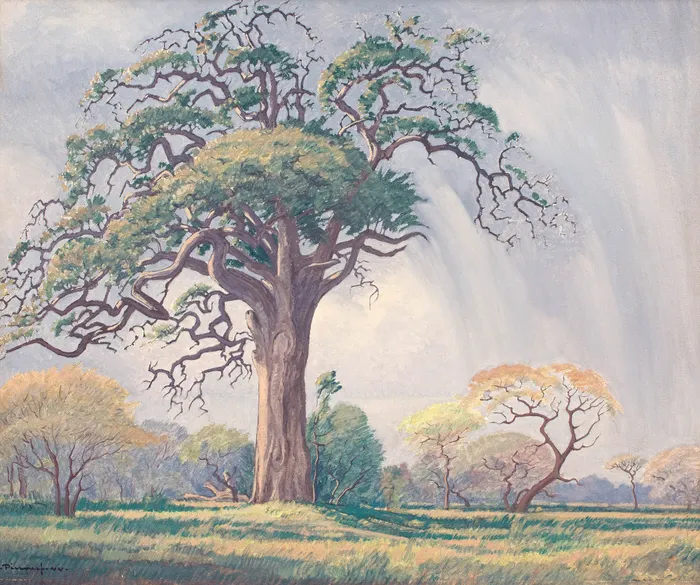Pierneef's works and other landscapes on auction

Pierneef’s ‘Hardekoolboom in a Bushveld Landscape’ (1944). Pierneef’s ‘Hardekoolboom in a Bushveld Landscape’ (1944).
“I have studied trees to the point of exhaustion I know every bend in its trunk. I could draw by heart every gnarl in its bark,” observed JH Pierneef, the painter renowned for his geometric paintings of trees and the landscape.
One of the results of the in-depth study of this tree, which cast a shadow in his garden, would be a pastel drawing titled Willow Trees in Summer (1913), which will go under the hammer at the Strauss & Co auction on October 16.
It will be joined by other Pierneef works colonised by trees, such as Hardekoolboom in a Bushveld Landscape (1944), which is expected to fetch up to R3 million, Trees in a Landscape and Bushveld Landscape.
As his later paintings revealed, he quickly jettisoned the sagging willow tree in favour of more upright ones that better suited his geometric angular language. He wasn’t the only artist focused on depicting natural environments.
If you peruse the artworks shown under the banner of important South African art at the Strauss & Co auction, it is clear this subject-matter determined art in the country for decades. From the first early white painters such as Thomas Baines, whose A South Easter off the Cape (1849) depicts a boat in a rough ocean, to Hugo Naudé works featuring the Hermanus coastline, Port St Johns, Victoria Falls, Maggie Laubser’s Yellow Bird, to Cecil Skotnes’s Head and Figure Landscape from the early ’90s, to Erik Laubscher’s abstract Evening Landscape.

Clarke’s ‘Girl with Goats’ (1974)
Stanley Pinker also embraced an abstract rendition of the landscape, while contemporary painter John Meyer digs into his hyper real cinematic vocabulary in Odysseus, an evening landscape, featuring a starry night sky.
The list is endless if you count Gregoire Boonzaier’s drawings of trees - Gnarled Tree (1991) and Twee Bloekombome Kaapsevlakte, Willem Hermanus Coetzer’s landscapes and Jan Ernst Abraham Volschenk’s The Sand Dunes of the Sea and Morning on the Veld.
The abundance of space, a love of the outdoors and the slow densification of urban cities (think of how SA cities grow outwardly rather than upwardly) explain this fixation with the landscape and nature, according to Esme Berman, the late art historian.
Dutch and French artists of the 19th century focused on still lifes and interior scenes. Those European countries lacked what she identified as the “peculiar intensity of light” - the brightness that is striking in South Africa.

Naudé’s Autumn in Hex River and Namaqualand, which pop with bright tones of yellow, orange and red confirm this idea. The sky is a crisp, bright blue in the latter work despite the season.
The more contemporary view, as taken up by art historians such as Juliette Leeb-du Toit, point to the obsession with the landscape as one tied to politics and establishing nationhood.
In his depiction of a boat in a storm, Baines may have been grappling with humankind’s relationship to nature, this desire to tame it, but it also could serve as a record not only of the arrival of British settlers but their desire to govern this supposedly “untamed” African territory.
It may also capture the uncertainty of his or his ancestors’ ambiguous status - caught between places. Establishing a sense of belonging drove much of the landscape tradition in painting by white artists, suggests Leeb-du Toit.
Afrikaner nationalism as tied to the mythology surrounding the Great Trek would find expression in both idyllic representations of the ’30s and ’40s by the likes of Volschenk and depictions of the then Transvaal, Orange Free State.
Upturning this drive and advancing democracy would play out through landscape art when the struggle movement gathered steam and artists turned on national or European narratives.
In the Long Journey, Peter Clarke depicts an old woman on crutches traversing a rural landscape, barren, barring a peculiar structure that appears like a large tooth - perhaps signifying a monument built by the Afrikaner state?
The beauty or breadth of the landscape, its pretty “light”, is obscured by twisted politics.
* Strauss & Co’s October 16 auction will take place at the Vineyard Hotel in Newlands.
View the works and join walkabouts from October 13 to 15 and view the works and details on www.straussart.co.za